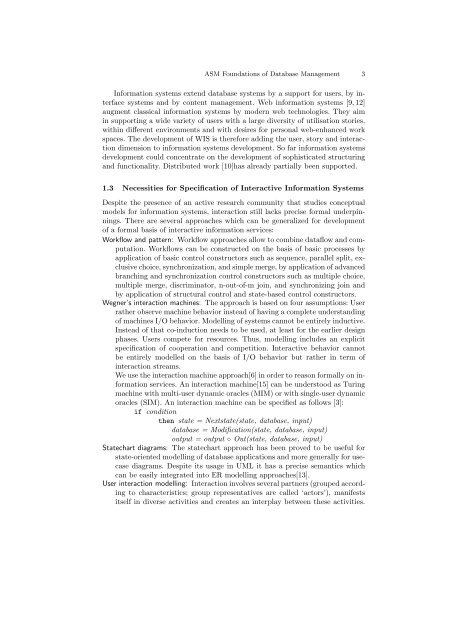BPMN and Beyond Business process modelling notation, workflow ...
BPMN and Beyond Business process modelling notation, workflow ...
BPMN and Beyond Business process modelling notation, workflow ...
You also want an ePaper? Increase the reach of your titles
YUMPU automatically turns print PDFs into web optimized ePapers that Google loves.
ASM Foundations of Database Management 3<br />
Information systems extend database systems by a support for users, by interface<br />
systems <strong>and</strong> by content management. Web information systems [9, 12]<br />
augment classical information systems by modern web technologies. They aim<br />
in supporting a wide variety of users with a large diversity of utilisation stories,<br />
within different environments <strong>and</strong> with desires for personal web-enhanced work<br />
spaces. The development of WIS is therefore adding the user, story <strong>and</strong> interaction<br />
dimension to information systems development. So far information systems<br />
development could concentrate on the development of sophisticated structuring<br />
<strong>and</strong> functionality. Distributed work [10]has already partially been supported.<br />
1.3 Necessities for Specification of Interactive Information Systems<br />
Despite the presence of an active research community that studies conceptual<br />
models for information systems, interaction still lacks precise formal underpinnings.<br />
There are several approaches which can be generalized for development<br />
of a formal basis of interactive information services:<br />
Workflow <strong>and</strong> pattern: Workflow approaches allow to combine dataflow <strong>and</strong> computation.<br />
Workflows can be constructed on the basis of basic <strong>process</strong>es by<br />
application of basic control constructors such as sequence, parallel split, exclusive<br />
choice, synchronization, <strong>and</strong> simple merge, by application of advanced<br />
branching <strong>and</strong> synchronization control constructors such as multiple choice,<br />
multiple merge, discriminator, n-out-of-m join, <strong>and</strong> synchronizing join <strong>and</strong><br />
by application of structural control <strong>and</strong> state-based control constructors.<br />
Wegner’s interaction machines: The approach is based on four assumptions: User<br />
rather observe machine behavior instead of having a complete underst<strong>and</strong>ing<br />
of machines I/O behavior. Modelling of systems cannot be entirely inductive.<br />
Instead of that co-induction needs to be used, at least for the earlier design<br />
phases. Users compete for resources. Thus, <strong>modelling</strong> includes an explicit<br />
specification of cooperation <strong>and</strong> competition. Interactive behavior cannot<br />
be entirely modelled on the basis of I/O behavior but rather in term of<br />
interaction streams.<br />
We use the interaction machine approach[6] in order to reason formally on information<br />
services. An interaction machine[15] can be understood as Turing<br />
machine with multi-user dynamic oracles (MIM) or with single-user dynamic<br />
oracles (SIM). An interaction machine can be specified as follows [3]:<br />
if condition<br />
then state = Nextstate(state, database, input)<br />
database = Modification(state, database, input)<br />
output = output ◦ Out(state, database, input)<br />
Statechart diagrams: The statechart approach has been proved to be useful for<br />
state-oriented <strong>modelling</strong> of database applications <strong>and</strong> more generally for usecase<br />
diagrams. Despite its usage in UML it has a precise semantics which<br />
can be easily integrated into ER <strong>modelling</strong> approaches[13].<br />
User interaction <strong>modelling</strong>: Interaction involves several partners (grouped according<br />
to characteristics; group representatives are called ‘actors’), manifests<br />
itself in diverse activities <strong>and</strong> creates an interplay between these activities.
















